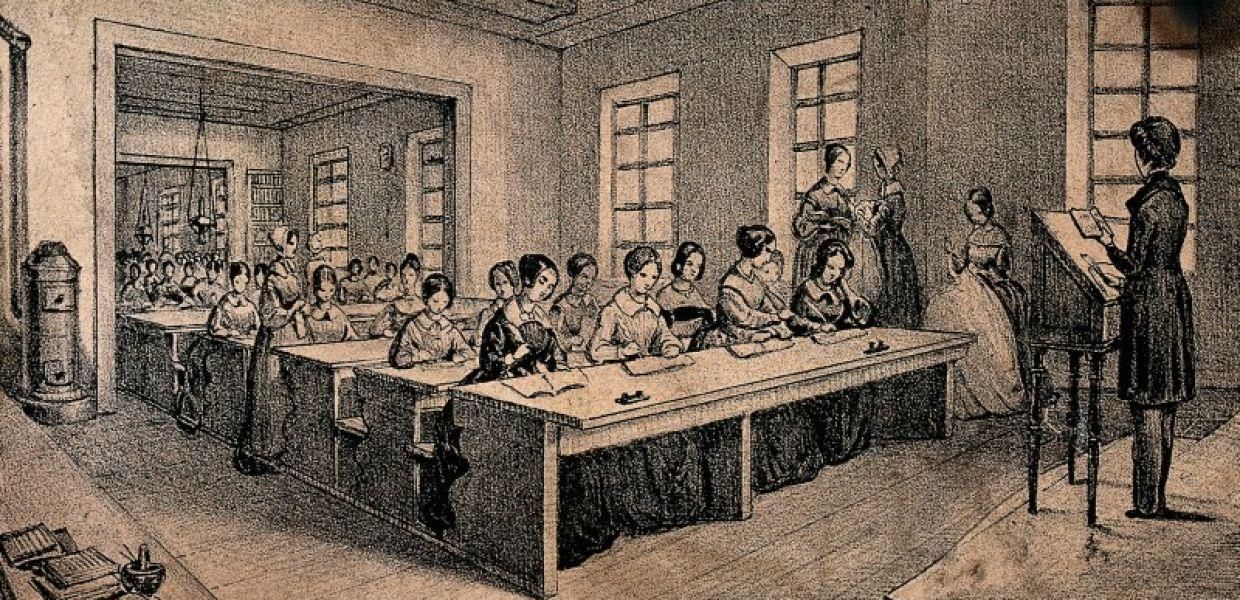Introducing the Europeana Data Model online course on data aggregation
This MOOC makes it easy for librarians and cultural heritage institutions professionals to understand how to bring their collections into Europeana.

- Title:
- A classroom with children sitting at long tables and a teacher standing with a book in her hand.
- Creator:
- J.B. Sonde
- Institution:
- The Wellcome Library
- Copyright:
- CC BY
During the second half of 2016, The European Library (TEL), which was the main library domain aggregator for Europeana, had the privilege of having Uldis Zarins, from the National Library of Latvia, as interim manager to help wrapping up with its overall activities and services. Over these months, the European Library staff worked with its partners - European and non-European institutions - to arrange possible alternative aggregation routes. As a result, two main scenarios were identified for their future data delivery to Europeana - either re-routing their data aggregation workflow through another data provider, possibly a national aggregator; or becoming a direct data provider to Europeana.
Working with partners to improve the understanding of EDM
Uldis recalls: ‘We realised that a large number of TEL partners were not in a position to use the services of another aggregator, and would instead become direct data providers . To identify the main challenges of becoming a Europeana data provider, we launched a survey, which revealed that one of the main stumbling blocks for libraries was data mapping and conversion to Europeana Data Model (EDM) - specifically from MARC 21, which is still the most commonly used data format for libraries. We looked for ways to boost the understanding of EDM among librarians, to explain how to translate MARC 21 elements to corresponding EDM fields, and to use the EDM for presenting their collections in Europeana. We noticed that the existing documentation on this topic was quite challenging to use, so we decided to try a more modern approach: we developed an online course to reach out and support libraries in their task of understanding Europeana data requirements.’
Working towards this goal, a group from the Europeana office worked to bring their knowledge on EDM and expertise of libraries data, outline the course structure, and compile the most relevant information regarding the Europeana Data Model. As a basis for the course, we looked at previous work done within Europeana, specifically to map the library specific format, MARC21, to EDM. We’ve brought some fun into all the serious data talk, with interesting ways to present and visualize these sometimes arid concepts. For example, some of the videos were filmed on the rooftop of the Koninklijke Bibliotheek, the institution that hosts our offices in The Hague, and we created a great animation of a poster getting all the way from a library shelf into Europeana Collections.
What to expect?
To give a short overview, the course is divided in 3 sections, as follows:
-
Section 1 - The basics of EDM - this first section presents the history of EDM, its development and the theory behind the main classes. We also explain what led to the creation of EDM and why Europeana needs it in order to keep on being the leading digital library for European cultural heritage.
-
Section 2 - Advanced specifications - this section delves deeper into the EDM classes and shows what impact each of the properties has on the final outcome on Europeana Collections. We also share the best practice we've acquired over the years, and explain what happens with your data here at Europeana before we publish it.
-
Section 3 - Transforming MARC21 to EDM - this final section highlights what the library domain professionals should consider when approaching specific data manipulation to EDM, and, further beyond, how such transformation is presented in the Europeana Collections site.
We invite you to discover this online course and we hope it will be useful to library institutions and other cultural heritage professionals!

